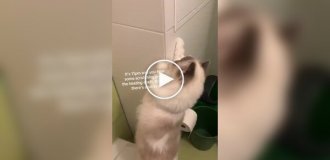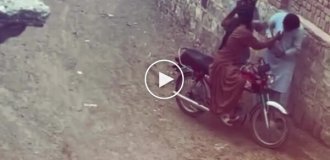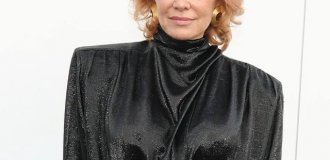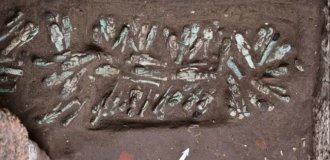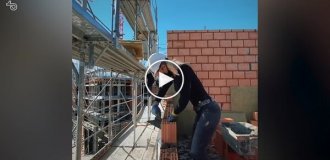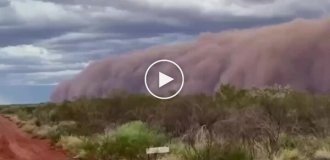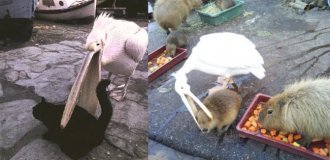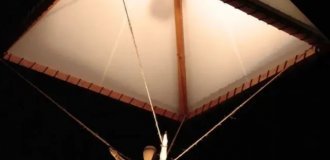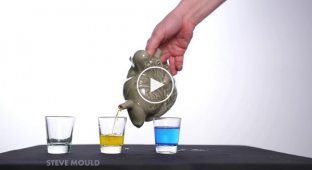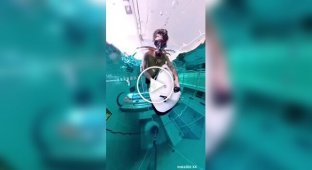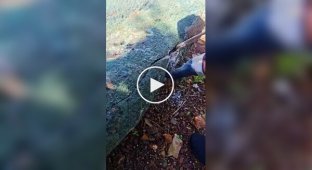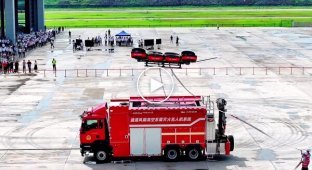The dragonfly is an arthropod, six-legged insect, belongs to the subclass of winged insects, order of dragonflies (lat. Odonata). The Russian name for the insect dragonfly was formed as a result of the merger of two Old Slavic words: the noun “egoza” (fidget) and the verb “strekkat” (jump or jump). This name fully corresponds to the flight pattern of these fast and nimble creatures.

Dragonfly: description, characteristics, structure, photographs.
Dragonflies have a characteristic, recognizable appearance. Their structure includes:
- slender, elongated, streamlined body (abdomen), often having a bright shiny color;
- large head;
- breast;
- wings.
The abdomen of insects is elongated and thin, round in shape; in some species of dragonflies it can be flat and wide. It is composed of 11 segments, consisting of two parts: ternite (upper semi-ring) and sternite (lower semi-segment). Males have “tongs” at the top of their abdomen, with which they hold the female by the neck during mating.

The dragonfly's head is movably connected to its chest, which gives it the ability to rotate around its axis by 180 degrees. The dragonfly's eyes, which occupy most of its head, consist of more than 30,000 small ocelli (facets). Moreover, each miniature eye is capable of working independently of the others. The upper part of the facets is designed to recognize the shape of an object, and the lower part – its color.

In addition to two compound eyes, dragonflies have 3 simple eyes on the crown of the head, which are arranged in a triangle. Thanks to the ability to see the environment not only in front, but behind them, as well as on the sides, dragonflies are able to notice prey at a distance of up to 8 meters.

The mouth of dragonflies is armed with serrated jaws, because they are voracious predators.

The chest has a structure characteristic of all insects and consists of a prothorax with a pair of limbs and fused mesothorax and metathorax, on which the paws are located.
The color of the dragonfly can be transparent, as well as green, yellow, blue or dark blue. Some species have patterns of spots or darkening on the body or wings.




Dragonflies have 2 pairs of wings. Dragonfly wings, depending on the species, can be the same or vary in size. Their maximum span reaches 18 cm. The wings consist of two thin layers of chitin, they are penetrated by a complex system of veins. Each of them has a special thickening at the top, which eliminates vibration during flight. When flying, dragonflies use 2 pairs of wings, and each wing can move independently of each other, each of the two pairs acts independently, but at the same time incredibly harmoniously, producing up to 150 beats per second. The maximum speed of a dragonfly is 57 km/h, and the average speed exceeds 30 km/h.


How long does a dragonfly live?
The lifespan of a dragonfly is on average 10 months. Many species die after 6 weeks. Centenarians can wait out unfavorable conditions (cold weather or periods of drought) in shelters.
Types of dragonflies, names and photographs.
Today, scientists have described more than 6,000 species of dragonflies, of which about 172, forming 52 genera, live in the CIS countries.
In the classification of dragonflies, there are 3 suborders:
- heteroptera dragonflies (lat. Anisoptera);
- homoptera dragonflies (lat. Zygoptera);
- anisozygoptera (combines the main characters of previous suborders).
Varied-winged dragonflies (lat. Anisoptera)
A characteristic feature of the suborder of heteroptera dragonflies is the perpendicular arrangement of the wings at rest and the difference in their size (the front wings of the dragonfly are much larger than the hind wings). The most famous representatives of heteroptera dragonflies are:
Dragonfly watchman-emperor or watchman-overlord (lat. Anax imperator), belonging to the family Rockers (lat. Aeshnidae) is a large insect with a wingspan of up to 11 cm and a body length of about 8 cm. The chest is green in color with black stripes. Males and females differ in the color of their wings and abdomen. Female dragonflies have golden-yellow wings and bluish-green bellies with large reddish-brown spots. The male dragonfly of this species is distinguished by colorless wings and a blue belly, on which dark brown spots are visible. Dragonflies appear in mid-June; the flight period lasts 1.5 months. They prefer to flutter near stagnant or low-flowing bodies of water. The Emperor Watcher is considered one of the largest dragonflies in Russia.

The Cordulegaster boltonii dragonfly is the only representative of the Cordulegasteridae family. The dimensions of this type of dragonfly are: body length up to 9 cm, wingspan about 10.5 cm. Oblique and transverse yellow stripes run along the abdomen and chest. The transparent wings of the dragonfly have black veins. Throughout the summer, they fly on the edges and forest clearings, near lakes and rivers with calm currents.

The metallic dragonfly (Latin: Somatochlora metallika), part of the family of grandmothers or patrollers (Latin: Corduliidae). A small insect, the body size of which does not exceed 4.5 cm, and the wingspan is only 3.5-3.8 cm. The general color of the chest and body is green with a metallic sheen. Yellow spots are visible on the first and third segments of the abdomen, and a thin yellow stripe runs along the forehead. The leading edge of the female dragonfly's wings has the same shade. The flight period of this species of dragonfly lasts from late May to mid-autumn. Metal headstocks are found near bodies of water with stagnant or low-flowing water.

The common dragonfly (lat. Gomphus vulgatissimus) belongs to the family Dedki or Rivermen (lat. Gomphidae). A rather small insect with a wingspan of about 3 cm and an abdomen length of up to 3.7 cm. The abdomen of the dragonfly is painted black with yellow spots located on the sides and a thin longitudinal stripe of the same color running across the top of the entire body. The lifespan of dragonflies of this species does not exceed 30 days. The dragonfly lives on forest edges and clearings near rivers, reservoirs or canals with a sandy and muddy bottom.

[media=https://www.youtube.com/watch?v=pFE77TPV_pk]
Homoptera dragonflies.
In representatives of the suborder Homoptera dragonflies, both pairs of wings are the same size, and when resting from flying, insects fold their wings and hold them in a vertical position above the body. The flight speed of these dragonflies is much lower than that of heteroptera. The most “bright” representatives of the suborder are:
Dragonfly Beauty girl or dark-winged beauty (lat. Calopteryx virgo), part of the Beauty family (lat. Calopteryg idae). These are medium-sized insects with a wingspan of up to 7 cm and a body length of about 5 cm. The color of the wings of males is bluish-blue, and the body color is greenish-blue with a metallic tint. Female dragonflies are characterized by transparent wings riddled with brown veins and a bronze-green body color. The beautiful female dragonfly lives along the vegetated banks of streams and rivers with a slow flow. The flight period begins in July and ends at the end of September. These dragonflies live in Europe, Siberia, the Far East, China, Japan, Mongolia, and Korea.
Female (left) and male (right)


Southern Arrow dragonfly (lat. Coenagrion mercuriale). Quite small dragonflies with a body length not exceeding 3.5 cm and a wingspan of about 4.5 cm. The male dragonfly has a bright blue body color with a dark heart-shaped spot. Females can vary in color from green to red-brown with black spots on each abdominal segment. You can see these insects in the air both in early May and mid-September. Dragonflies fly near large bodies of water or slow-flowing rivers

[media=https://www.youtube.com/watch?v=jaRS_DKin_4]
The dragonfly Lyutka-dryad (lat. Lestes dryas) is a representative of the Lyutka family (lat. Lestidae). A small dragonfly with a body length of about 3.5-4 cm and a wingspan of up to 3-4 cm. The color of males and females is the same - bronze-green on top, and with a yellow tint on the sides. The edges of the transparent wings are framed by a brown border. These dragonflies begin to fly from the beginning of July to the first days of September. The lute-dryad dragonfly lives near warm and shallow, sometimes drying up reservoirs with abundant aquatic vegetation.

Megaloprepus caerulatus is the largest dragonfly in the world. Individuals of this species can reach 10 cm in length and have a wingspan of up to 19 cm. Adult dragonflies feed on spiders, grabbing them in flight directly from the catching web. The wings of these insects are transparent with brown veins, with a wide blue vertical stripe at the tip of the wing. This stripe contains pale blue round spots, sometimes merging into a single stripe. The wide stripe on the underside of the dragonfly's wings is black. The first and second pairs of wings are almost identical in size and structure. The largest dragonfly in the world lives in humid and damp forests in Central and South America.

[media=https://www.youtube.com/watch?v=sg6WP35-6e8]
Where do dragonflies live?
The habitat of dragonflies is very extensive. They can be found in any region of the world where the weather is warm, there is water and a large supply of food. These insects are widespread in Russia and Belarus, Germany and France, Italy and Spain, and the countries of the Balkan Peninsula. Many species of dragonflies live in the Asian region: India and Pakistan, Thailand and Azerbaijan, Armenia and Iran, Turkey and China. The dragonfly also lives in the vastness of the African continent, Australia, North and South America.
The dragonfly is an insect that prefers a solitary lifestyle. It is active during the daytime, preferring sunny hours, and waits out unfavorable cloudy weather in shelters. Natural enemies of dragonflies include many species of birds, fish and spiders.




What do dragonflies eat?
By the nature of their feeding, dragonflies are typical predators that catch their prey on the fly. Each individual has its own hunting grounds, which they zealously defend from strangers and, if necessary, fight for them. The main food of dragonflies is flies, mosquitoes, moths and other small flying insects. Large individuals are capable of eating small fish, spiders and frogs.
Dragonfly larvae (naiads) feed on young fish, small aquatic insects, crustaceans, and larvae of flies and mosquitoes. This diet is determined by the aquatic habitat. In addition, they clean the reservoir from decaying remains of animal and plant origin.


[media=https://www.youtube.com/watch?v=L36lbLuHI9M] [media=https://www.youtube.com/watch?v=tuPsLgXVEgM]
Reproduction and development of dragonflies. How is a dragonfly born?
During the mating season, male dragonflies gather in huge flocks and patrol areas located near water bodies.
After fertilization, the female dragonfly flies to a pond and leaves eggs directly in the water, placing them inside underwater or above-water parts of plants. The number of dragonfly eggs can reach 600 pieces.
The development cycle of dragonflies is incomplete. The transformation into a mature individual occurs without the pupation stage. The egg stage period lasts from 14 to 35 days. After which, a naiad larva emerges from the dragonfly egg and continues to develop under water. The dragonfly naiad breathes using peculiar gills located in the hindgut. To supply the body with oxygen, the larvae constantly suck water into it through the anus. They push the “waste” liquid out with force and thus move using the principle of a jet engine.
During the larval stage, the molting process occurs up to 15 times. As the dragonfly larva grows, it begins to grow wings, which are still fragile when the insect emerges into the air. The last change of “skin” occurs on land, and an hour later the dragonfly is ready for its first flight. The dragonfly larval stage, depending on the species, can last up to 3 years.
fertilization

egg laying

eggs

naiad larva

[media=https://www.youtube.com/watch?v=sbExgcTPAek]
- The eyes of a dragonfly, in addition to the normal spectrum, are capable of perceiving ultraviolet light.
- Without having a sufficiently developed brain, these insects are able to calculate the flight path of the victim with 95% accuracy.
- Entomologists still have not found an explanation for the mysterious flights of a huge cluster of dragonflies across ocean spaces. They make such trips every 6-7 years.
- In Japan, the dragonfly is considered the standard of military valor and courage.
- On the island of Shikoku there is a park called the “Dragonfly Kingdom”. Everything in it is dedicated to this insect. In addition to the variety of species that live here, the design of the fences surrounding the clearings and the railings of the bridges thrown over artificial ponds is made in the “dragonfly” style. In the park's shops you can buy literature dedicated to these insects and see paintings depicting them.
Evolution of dragonfly-like insects
The ancestors of modern dragonflies appeared on the planet long before the dominance of dinosaurs and were the first creatures to conquer the air. Modern dragonflies and all fossil dragonfly-like insects are grouped into the superorder or clade Odonatoptera. There are still many gaps in the geological history of dragonflies. Thus, the Mesozoic fauna is known almost exclusively from finds in Eurasia. In the early Permian period, real giants appeared among dragonflies: Meganeuropsis had a wingspan exceeding 70 cm. These are the largest of all known insects. To fully describe the phylogeny of dragonflies, there are few fossil finds from the Triassic, especially the Early Triassic, period. Information on dragonfly species from the Early Cretaceous is largely limited to finds in East Asia.



I suggest watching an interesting documentary about dragonflies.
P.S.
I hope you liked the story about these amazing insects. I’m interested in your opinion, write in the comments about which representatives of the fauna you would like to read more about.

